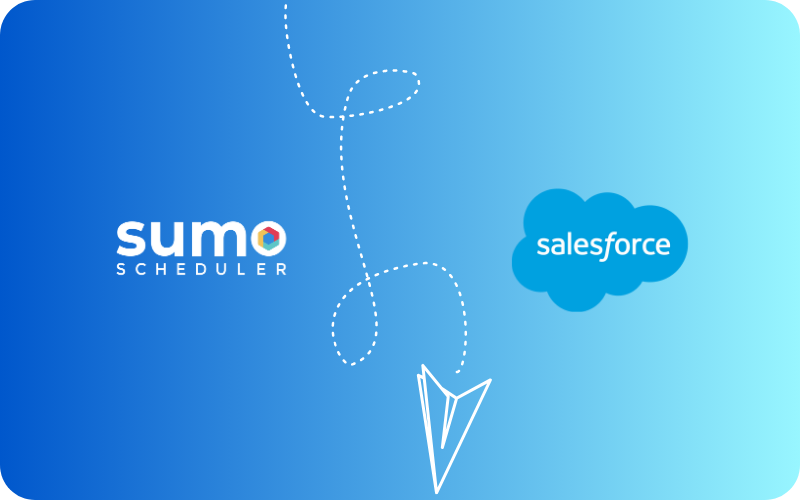If you’re exploring Salesforce scheduling options, the first ones that come to mind are Salesforce Scheduler and SUMO for Salesforce. Both allow you to automate repetitive tasks, streamline customer service, increase lead conversion, and ultimately help your company achieve its goals. So, which one to choose?
In this post, we’ll provide an in-depth comparison of Salesforce Scheduler and SUMO for Salesforce highlighting their key features and capabilities to help you decide on the right CRM scheduling software.
Key Takeaways
- Salesforce Scheduler and SUMO are two scheduling solutions 100% native to Salesforce meaning you don’t need external API integrations to manage appointments in your CRM. The first one is built by Salesforce and comes as an add-on in its editions. The second one, SUMO, is built with Salesforce Lighting and deployed via the AppExchange managed package.
- Salesforce Scheduler caters to users’ basic appointment booking needs. SUMO enables advanced scheduling scenarios for mid-to-large enterprises across industries like healthcare, education, financial services, government, banking and service companies.
- Among SUMO’s advantages over Salesforce Scheduler are ease of use, powerful built-in features, extensive customization capabilities, in-depth meeting analytics, seamless integrations with most popular tools and dedicated team support.
- For all things customization, Salesforce Scheduler needs an experienced Salesforce admin. For organizations with complex availability rules, it requires extensive customization and doesn’t scale efficiently. In contrast, SUMO is intuitive, easily adopted, and maintained no matter your tech level, providing a lower life cycle cost. Its module-based tools are easy to install, configure, and use out of the box without requiring customization.
- Being a Customer Engagement Platform, rather than just a scheduling tool, SUMO provides event scheduling and field sales capabilities, which are lacking in Salesforce Scheduler and other solutions like Calendly.
The Story Behind SUMO for Salesforce
On my first interview with Todd Adams, CRO at SUMO Scheduler, I had 5 minutes left to ask questions. I managed just one: How are you better than your competitors? With 16 years in sales, Todd knows his 3-minute elevator pitch. He said.
“SUMO is the first Salesforce native scheduling solution on the AppExchange. When compared to competitors, our advantage is that we are a fully native solution that is extremely powerful, easy to implement, simple to use and highly customizable. It’s extremely mature — we’ve been working on it for 12 years. Salesforce often recommends SUMO for complex scheduling needs — and we’re still ahead of the competition when it comes to native features and overall value.”
Working on a product with a real competitive edge is a marketer’s dream coming true. But for Salesforce consultants and organizations searching for a powerful native CRM scheduling tool, choosing the right solution means considering many factors. So, let’s see what SUMO and Salesforce Scheduler have to offer in terms of features, integrations, and customization capabilities.
Salesforce Scheduler vs SUMO: Side-by-Side Comparison
Salesforce Scheduler and SUMO for Scheduler are two native appointment scheduling platforms designed to efficiently collect, manage and moderate incoming booking requests in Salesforce. Here, we state the key feature differences between the two.
✅ – fully available and ready-to-use without coding or external software needed.
❌ – limited or not supported out-of-the-box and requires either manual setup thought coding or external software add-on.
| SUMO Scheduler | Salesforce Scheduler | |
| Salesforce Native | ✅ Built on Salesforce | ✅ Built by Salesforce |
| Appointment Types | ✅ (1-1, 1-many, many-many, recurring, on-demand) | ✅ (1-1, 1-many, many-many, recurring) |
| Event Types | ✅ (1-1, 1-many, many-many, recurring, on-demand) | ✅ Requires config & capacity logic for group appointments, no recurring |
| Assignment Logic | ✅ Round robin, priority based, load balancing & custom | ❌ Round robin only |
| Multi-Resource Scheduling | ✅ | ✅ |
| Meeting Temples | ✅ 1h, 30-min & custom | ✅ less granular |
| Smart Reminders | ✅ Automated, SMS+Email, with custom reminder logic | ❌ Email only, manual setup |
| Self-Scheduling Portal | ✅ Via website, email, text, social media. Works with any Enterprise license | ❌ Requires customization & an Experience Cloud licenses |
| Self Service Scheduling with Travel Time | ✅ Built-in | ❌ Not available |
| Appointment Flow Customization | ✅ Custom booking flows, branding | ❌ Requires coding |
| Reporting & Analytics | ✅ Advanced Dashboards & Meetings Stats | ❌ Limited to Salesforce reporting analytics guardrails |
| External Calendar Sync | ✅ Google, Outlook, Exchange, Salesforce Calendar | ❌ Salesforce Calendar only |
| Video Conferencing | ✅ Zoom, MS Teams, multi platform integration | ❌ Amazon Chime only |
| Mobile Friendly | ✅ fully responsive | ✅ fully responsive |
| Best For | Advanced appointment, event and field sales scheduling Healthcare, EdTech, Retail, Service Companies, Filed Sales, Government, Nonprofits, Legals, Banks, Sales teams. | Basic appointment scheduling Finance, Sales and Marketing teams, companies already using Salesforce with dedicated tech resources. |
| Free Trial | ✅ 14-day sandbox trial, expertly led & guided | ✅ Self-paced trailhead |
Try SUMO Scheduler today and see how easy scheduling can be!
Both Schedulers come packed with features and most likely you don’t need them all at once. So, which one fits your business best? Let’s break them down by core features and state the key differences between the two solutions.
Appointment Booking: SUMO vs Salesforce Scheduler
Appointment booking is the cornerstone of any scheduling software. Even small features can make a big difference—so let’s break them down one by one, checking off how SUMO and Salesforce Scheduler help you automate appointments and meetings inside your CRM.
| Feature | SUMO for Salesforce | Salesforce Scheduler |
| Direct Calendar Integration | ✅ Google, O365, Exchange & Salesforce Calendar | ❌ Requires 3rd party connector |
| 1 to 1 Appointments | ✅ | ✅ |
| 1 to Many Appointments | ✅ | ✅ |
| Concurrent Scheduling (Many to Many) | ✅ | ✅ |
| Recurring Appointments | ✅ | ✅ |
| Round Robin | ✅ | ✅ |
| First available, Priority based & Load balanced Appointments | ✅ | ❌ |
| Meetings Templates | ✅ | ✅ |
| Reminders | ✅ (Email + SMS) | ✅ (Email Only) |
| Reschedule / Cancel | ✅ (Email + SMS) | ✅ (Email Only) |
| Real-Time Scheduling | ✅ | ✅ |
| Personal Meeting Links | ✅ | ✅ |
| Group Booking Links | ✅ | ✅ (requires customization) |
| Schedule from Any Website | ✅ | ❌ |
| Schedule on behalf | ✅ | ❌ |
| Buffer Times | ✅ different for each user | ✅ one for all users |
| Upload / Attach Documents | ✅ | ❌ |
Both SUMO & Salesforce Scheduler supports:
- Online appointment bookings
- Different appointment types (1-1, 1-many, many-many, recurring)
- Round Robin appointments
- Email reminders with option to reschedule or cancel
- Meeting buffer time
- Self-Scheduling Portal: Salesforce scheduler can also embed their portal links in a website, mobile or widgets but needs customization. The main difference lies in the branding/theming and the type of users you want to access the portal. With SUMO, regardless of the users, it is a free-pass portal meaning no login required. With Salesforce Scheduler, authenticated users (requires login) is native to them but unauthenticated users are not.
Appointment scheduling features only available in SUMO:
- First available, Priority based & Load balanced Appointments: SUMO includes build-it appointment assignment logic flows allowing you to automatically distribute appointments among team members without conflicts. Salesforce Scheduler does not offer them as a standard feature. To enable custom appointment flows, you need to code in Flow Builder.
- Real-Time Scheduling: SUMO lets you instantly update and adjust schedules based on live changes, e.g. reschedules, late-minute cancellations.
- Meeting Links: SUMO provides custom links for any appointment types be it a 1:1 personal meeting link in your email or event registration link on your site for many attendees. In Salesforce Scheduler, you can’t directly generate a link that someone can use to schedule a meeting with you and have it automatically create a Salesforce event.
- Schedule on behalf: SUMO lets you schedule meetings for other team members. It’s especially useful in government offices, healthcare, or sales teams where one person handles bookings for others.
- Upload / Attach Documents: With SUMO, people can upload documents along with appointment setting up. In Salesforce, it requires coding.
Event Booking: SUMO vs Salesforce Scheduler
| Feature | SUMO for Salesforce | Salesforce Scheduler |
| 1 to Many Event Booking | ✅ Unlimited | ✅ 25 participants max /per appointment |
| Many to Many Event Booking | ✅ | ✅ |
| Online Event Registration Sites | ✅ | ❌ |
| Multi-Event Links | ✅ | ❌ |
| Paid Events | ✅ | ❌ |
| Event Desk with QR Code Support | ✅ | ❌ |
SUMO includes a well-rounded event management kit. You can enable online booking for courses, classes, webinars, or in-person sessions, making it easy for participants to register and manage their schedules. Built-in features like waitlists, automated reminders, capacity limits, and multi-session scheduling help organizers run smooth, scalable events.
Salesforce Scheduler primarily focuses on one-on-one appointment scheduling and does not offer dedicated event booking features. While it does support multi-resource and concurrent scheduling, they better suit individual appointments rather than large-scale events. For handling registrations, payments, ticketing, or managing large attendee groups, you’ll need third-party integrations.
Field Sales: SUMO vs Salesforce Scheduler
| Feature | SUMO for Salesforce | Salesforce Scheduler |
| Self Service Scheduling with Travel Time Automation | ✅ | ❌ |
| Travel Time Calendar Sync (Google, Office365, Exchange) | ✅ | ❌ |
| Assign Users by Zones & Areas | ✅ | ✅ |
SUMO provides a solid kit for managing Field Service and Sales appointments. With real-time calendar sync, intelligent time buffers calculated based on the route, and customizable booking flows, teams can schedule faster and respond to customer needs without delay.
Salesforce Scheduler can factor in travel time between appointments if you customize it or integrate with Salesforce Maps. Native support is limited. You can define Service Territories (zones/regions) and assign resources (field reps) accordingly. Scheduler respects territory-based assignment.
Customization: SUMO vs Salesforce Scheduler
Customization features help you maximize brand presence, enable the booking flow that meets your and your audience needs.
| SUMO for Salesforce | Salesforce Scheduler | |
| Custom Booking Flows | ✅ | ❌ |
| Custom Meetings Links | ✅ | ❌ |
| Branded Booking Pages & Portals | ✅ | ❌ |
| Custom CSS | ✅ | ✅ |
| Time Zone Sync | ✅ | ✅ |
SUMO gives you complete freedom to create any scheduling flow no-code: multi-location, multi-user and multi-service. The interface is intuitive and user-friendly, with drag-and-drop functionality and minimal setup requirements. You can create fully branded booking portals without extensive training or technical expertise.
Salesforce Scheduler requires admins and pro-level users to customize the flows, looks, and features. If you’re on a business side and don’t feel like mastering coding, it will take days if not weeks to set up the scheduling flow you need.
Integrations
| Feature | SUMO for Salesforce | Salesforce Scheduler |
| Google, Office365, Outlook & Salesforce Calendars | ✅ | ❌ |
| Payments with Stripe | ✅ | ❌ |
| Zoom, Microsoft Teams | ✅ | ❌ |
| Google Analytics | ✅ | ✅ |
| Open Scheduling API for Easy Integration | ✅ | ❌ |
SUMO integrates with a variety of tools you use everyday. You may enable or disable the ones you need. Google Calendar, Microsoft Office365, Microsoft Exchange, Microsoft Teams & Google Meet. For paid events SUMO integrates with Stripe.
Salesforce integrates with a ton of apps but those integrations aren’t included in the Scheduler. Salesforce Scheduler’s only native video conferencing integration is Amazon Chime. If you want to book a Zoom meeting via Salesforce Scheduler, you’ll need to manually copy and paste the meeting link into the event’s location field.
Calendar Syncs
SUMO offers a no-code, user-friendly integration with Outlook and Google Calendar. Just connect your accounts, set your sync preferences, and you’re done. Non-technical users can easily adopt SUMO, making setup simpler and more intuitive than Salesforce.
Salesforce Scheduler only pulls availability from the Salesforce Calendar. To sync with Microsoft or Google calendars, you need API setup or Einstein Activity Capture.
Analytics
SUMO offers built-in meetings analytics to help teams track, measure, and optimize appointment scheduling performance. Users can access real-time dashboards and reports directly within Salesforce, covering metrics like booking volume, agent utilization, and no-show rates.
Salesforce Scheduler doesn’t come with out-of-the-box reporting or dashboards; admins have to manually build them.
Pricing
Salesforce Scheduler price is $25/user/month billed annually on top of the cost of Salesforce licenses. Available within Enterprise and Unlimited Sales Cloud and Service Cloud.
Discounts: no
Partnership program: no
SUMO is subscription-based per user or per feature starting from $31 user/month.
Discounts: yes, nonprofits
Partnership program: yes
What are Salesforce Scheduler Alternatives?
On Reddit threads about Salesforce Scheduler users underdeveloped features and complicated customization. Users are either looking for Salesforce Scheduler alternatives or recommending one.
Among the most common suggestions is Calendly. But how is it different from Salesforce Scheduler and SUMO? In many ways. First, let’s break down the general approach to managing scheduling in Salesforce.
Native Software
Scheduling from any Salesforce object with all data syncing in your CRM.
Pros
- ‘Plug and play’ functionality
- Minimal setup
- Enterprise-grade security backed by Salesforce
- No access to customer data, Salesforce stores all information
- Extensive customization options
Speaking the business language, native scheduling software saves your budget on custom dev, speeds up implementation time meaning sooner lead flow, meaning higher profits.
API integration
Requires more initial setup, as you’ll need to configure and integrate an external API with Salesforce. It may involve more complex coding or using third-party integration tools (like Zapier, MuleSoft, or custom-built connectors).
If the third-party scheduling tool is not fully Salesforce-native, the integration might involve data synchronization issues or maintenance challenges.
Unlike Calendly, SUMO is built natively on Salesforce, meaning it works seamlessly within your CRM without the need for external integrations. This native approach keeps your data secure, streamlines scheduling workflows, and delivers a smoother, more consistent user experience for both your team and customers.
Read more: Salesforce Native Scheduling: Why a Managed Package is the Best Choice
Salesforce vs SUMO: Which Scheduler to Choose
Salesforce Scheduler (aka Lightning Scheduler) is a paid add-on built in Salesforce CRM. Released back in 2020, it enables you to schedule meetings and appointments with basic flow.
Well-embedded in most Salesforce workflows due to its “in-built” nature, it allows users to book rooms, manage schedules, and confirm meeting times. Still, you’ll face many limitations when it comes to external integrations or client-specific customizations.
Consider Salesforce Scheduler if you
- Need basic appointment booking
- Have a bunch of experience with Salesforce
- Ready to invest time & resources in development and configuration
Built on Salesforce’s Lightning Platform, SUMO provides a native Salesforce scheduling solution that is secure, reliable and enables automatic logging of activities and appointments directly in Salesforce records. This ensures your sales and customer support teams have a 360-degree view of customer interactions without needing to toggle between platforms.
As part of the Salesforce ecosystem, SUMO Scheduler benefits from the robust security features and compliance measures already in place within Salesforce.
Choose SUMO if you
- Look for a better Salesforce Scheduler alternative while keeping it native to Salesforce
- Need advanced scheduling tool with custom flows
- Prioritize ultimate control and flexibility
- For group booking, event booking, course scheduling, panel interviews
- Have low tech capacity
- Plan to scale in future (and you will)
- Need a quick launch
Experience the difference firsthand!



